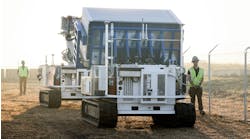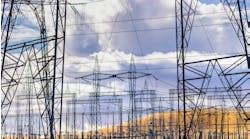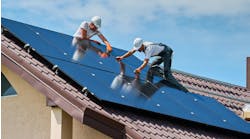As commercial and utility-scale solar projects become more widespread, fires and failures should not. Unfortunately, the number of rooftop solar installation fires in the United States increased 69% between 2016 and 2018, according to U.S. Fire Administration data. Unprotected, improperly connected, or incompatible connectors are some of the most common causes of photovoltaic (PV) panel failure and fires.
Meanwhile, with utility-scale installations now typically reaching 1,000V or 1,500V, protecting workers against ground faults and arc flash incidents is critical. Although no solar-specific data is available, OSHA statistics show the utility and construction industries experience the highest rates of both fatal and nonfatal electrical injuries.
One fact is certain: Fires, faults, and electrocutions are a real risk with PV installation. The good news is that safety hazards can be mitigated with the right knowledge and practices, and by expanding their familiarity beyond what’s covered by the requirements of NEC Art. 690.
Article 690 [Solar Photovoltaic Systems] outlines many safety and performance requirements but isn’t comprehensive enough on its own to prevent all possible injuries (nor should it be). Often, Art. 690 and UL standards work together, such as with arc-fault circuit interrupters (AFCIs). Nevertheless, there are gaps, such as ensuring cables remain secured in place during a short circuit event.
This is where international standards such as IEC and IEEE can provide guidance because in areas such as grounding and bonding, internationally recognized standards are often stricter than U.S. standards. That’s not to say NEC and UL standards are at odds with international standards. In fact, UL and IEC have worked together to align codes on things like general cable management as well as more specific PV safety requirements. This growing move toward standards harmonization will help the industry by streamlining requirements and improving safety across the board.
This article provides an overview of a few UL, IEC, and IEEE standards that can work with NEC guidelines to improve the safety of commercial and utility-scale solar installations.
Art. 690 update: connectors and intermating
Manufacturers have been warning against intermating connectors for years. Despite these cautions, the practice of combining different kinds of connectors has become commonplace due to the increased availability of cheaper, generic connectors, MLPE devices, and prewired components. Although different brands of connectors may appear to be compatible and are UL-certified, no single standard exists for connector size, tolerances, or materials. The contacts inside might be copper or they could be steel, bronze, or aluminum alloy. They may connect without any noticeable issues upon installation but, over months or years, small design differences will lead to wear, contact resistance, and — at worst — catastrophic failure.
Article 690 was revised in 2020 to prohibit intermating, with Sec. 690.33 of Part 4 now stating, “Where mating connectors are not of the identical type and brand, they shall be listed and identified for intermatability, as described in the manufacturer’s instructions.” Oftentimes, however, major manufacturers’ warranties prohibit mating of their connectors with products from other suppliers rather than allow it, as is suggested in the updated NEC language.
Ground-fault and arc-fault circuit protection
Article 690 requires arc and ground-fault detection and interruption as well as rapid shutdown capabilities on rooftop PV installations in case of fire (Secs. 690.5, 690.11, and 690.12, respectively). Although Art. 690 requires the installation of devices such as arc-fault circuit interrupters (AFCIs) and shutoff switches, it does not outline performance requirements for these devices. Instead, it requires them to be tested and listed to UL1699B, Standard for Photovoltaic (PV) DC Arc-Fault Circuit Protection, which was developed specifically for Art. 690. The difficulty of measuring arc faults initially led to some issues with 1699B testing.
After its introduction, several AFCIs listed under it were found to be sensitive to unwanted tripping or unable to detect arc-fault events. This is because the standard tested devices for performance under an instantaneous arc fault instead of the gradual buildup of deteriorating conditions that often lead to faults in the real world. Updates in 2016 and 2018 addressed this issue. The updates also included better-defined testing parameters and testing to ensure performance when the PV array is a further distance from the inverter or arc detection circuit.
The general standard governing AFCIs, UL 1699B, was used as the basis for IEC’s international standard (62606:2013), but the two are not identical. Although not yet approved, IEC 63027 will fill a similar role as UL 1699B, covering AFCIs for PV systems.
Wiring methods and materials
Wiring methods and materials are covered in Part 4 of NEC Art. 690. It allows for cable trays in outdoor PV installations but classifies cable trays as support systems, not raceways. Compared to a raceway, exposed cables in a cable tray are at greater risk of damage and present greater risk in a fire situation. This makes properly securing cables especially important. Article 690 states that cables in a cable tray must be supported at intervals of 300 mm (12 in.) and secured at least every 1.4 m (4.5 ft) but does not specify how they are to be secured.
A short circuit event can release a considerable amount of force before fault protection devices have time to react, and with electromagnetic force ranging upwards of 10,000 pounds, the damage can be significant. IEC 61914:2015 sets standards for resistance to electromechanical forces and outlines testing requirements for temperature rating, corrosion, UV resistance, and more to ensure that cable cleats can withstand harsh construction site conditions. Cable cleats that meet IEC 61914:2015 exceed the NEC’s safety requirements and should be used whenever possible.
Grounding and bonding
UL 467, the general safety standard for grounding and bonding equipment required by the NEC, includes requirements for tensile force strength, short time current, and corrosion-resistance testing, as well as direct burial rating and markings. To mitigate hazards, UL 467 should be considered a baseline rather than the finish line.
A more stringent standard is IEEE 837-2014, Standard for Qualifying Permanent Connections Used in Substation Grounding, which addresses the connections used in the grid system to join ground leads to the grid system, equipment, and structures. Like UL 467, IEEE 837 is a general grounding and bonding standard not specific to PV systems. In fact, compliance with the IEEE standard requires an acceptable pull-out test rating under UL 467. Unlike the UL standard, compliance is self-proclaimed by the manufacturer, but manufacturers should be able to provide test data to back up their claim.
The IEEE 837 short time current test requirements are stricter than UL 467 and designed to mimic a utility-scale fault. It also requires additional sequence testing designed to emulate harsh and heavy environmental conditions.
Standards harmonization
Joint certifications, such as those between UL and IEC, are becoming more common. For manufacturers, having to comply with multiple standards can be costly — especially where conflicting standards require the design of different product models. Harmonization eliminates that redundancy and reduces the amount of testing required. For engineers, installers, and EPCs, it helps simplify product selection.
The joint IEC/UL 62275 standard for cable management systems, which has been in place since 2016, specifies requirements for cable ties and associated fixing devices used in electrical installations. IEC/UL 62109 was also published in 2016, which aligned UL 1741 (Inverters, Converters, Controllers, and Interconnection System Equipment for Use with Distributed Energy Resources) with IEC 61209, resulting in a unified standard that defines the minimum requirements for the design and manufacture of power conversion equipment and inverters for protection against electric shock, energy, fire, mechanical, and other hazards.
Most recent is the development of IEC/UL 61730 (Standard for Photovoltaic Module Safety Qualification), which harmonizes UL 1703 (Flat-Plate Photovoltaic Modules and Panels) with IEC 61730. In effect since December 2019, this unified standard encompasses construction and the testing requirements relating to solar panel electrical, mechanical, thermal, and fire safety.
Even if standards aren’t harmonized, building installations to stricter international standards is beneficial because it helps future-proof projects against future standards harmonization. While harmonization is moving in the right direction, it’s important to note that there are also standards gaps, such as with connectors. And even though Art. 690 now prohibits intermating, the development of an industry standard for PV connectors would resolve the problem entirely.
Wrapping it up
Ultimately, there’s no magic wand that can be waved or single standard that can be applied to remove all risk from the PV installation process. However, the inclusion of standards to complement Art. 690 is one way to keep engineers and installers safe is both viable and practical.
Amit Mehta is a senior product manager with Panduit.



